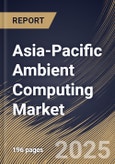The China market dominated the Asia-Pacific Ambient Computing Market by country in 2024, and is expected to continue to be a dominant market till 2032; thereby, achieving a market value of $25.89 billion by 2032. The Japan market is experiencing a CAGR of 24.5% during 2025-2032. Additionally, the India market is expected to exhibit a CAGR of 26.2% during 2025-2032. The China and Japan led the Asia-Pacific Ambient Computing Market by Country with a market share of 36.8% and 18.2% in 2024.The Singapore market is expected to witness a CAGR of 28.2% during throughout the forecast period.
Ambient computing in the Asia-Pacific region has grown from small pilot projects to big, integrated systems that work in homes, cities, factories, and public places. Because of national digital agendas and strong OEM participation, the region now sees intelligent, context-aware systems as necessary infrastructure instead of just nice-to-have technology. Improvements in broadband, 5G, and edge computing make it possible to process data locally, which speeds up responses and protects privacy. Some important trends are edge-first architecture, trust-by-design principles, and the merging of areas like safety, energy, and mobility into flexible, unified environments. This change shows a move away from managing devices and toward operations that focus on outcomes, such as safety, efficiency, and user experience.
Leading companies in the area say that modular, edge-centric platforms, ecosystem partnerships, and trust are what set them apart. Telecoms, OEMs, and integrators work together to provide ambient solutions that can grow and work with other systems. These solutions are backed by local government and contracts that are based on results. There is a lot of competition between global and regional companies that are putting AI into appliances, infrastructure, and city systems. Increasingly, success depends on being open, protecting people's privacy, and being able to reliably manage different device ecosystems across portfolios. Basically, Asia-Pacific is turning ambient computing into a basic part of digital life and industry change.
Type Outlook
Based on Type, the market is segmented into Services, Software and Hardware. With a compound annual growth rate (CAGR) of 23.7% over the projection period, the Services Market, dominate the Japan Ambient Computing Market by Type in 2024 and would be a prominent market until 2032. The Hardware market is expected to witness a CAGR of 25% during 2025-2032.Technology Outlook
Based on Technology, the market is segmented into Edge AI, Machine Learning (ML), Computer Vision, Natural Language Processing (NLP), Voice & Gesture Recognition, Deep Learning (DL) and Other Technology. Among various Singapore Ambient Computing Market by Technology; The Edge AI market achieved a market size of USD $149 Million in 2024 and is expected to grow at a CAGR of 27 % during the forecast period. The Voice & Gesture Recognition market is predicted to experience a CAGR of 28.9% throughout the forecast period from (2025 - 2032).Country Outlook
Japan’s ambient computing market is driven by its advanced technology base, aging population, and strong heritage in electronics, robotics, and automation. Government initiatives like “Society 5.0” and smart city programs, along with widespread broadband and 5G/6G testbeds, provide a solid foundation for growth. Key trends include edge and distributed computing for low-latency, privacy-conscious operations, and domain-specific applications across smart homes, factories, healthcare, and mobility. Major players such as Panasonic, NEC, Hitachi, and Sony integrate ambient capabilities into existing products, while startups focus on sensors and inference modules. Collaboration among telecoms, system integrators, and municipalities supports pilot deployments. However, challenges like high costs, privacy concerns, and integration with legacy systems must be overcome to achieve large-scale adoption.List of Key Companies Profiled
- Amazon.com, Inc.
- Microsoft Corporation
- Samsung Electronics Co., Ltd. (Samsung Group)
- IBM Corporation
- Apple, Inc.
- NVIDIA Corporation
- Qualcomm Incorporated (Qualcomm Technologies, Inc.)
- Intel Corporation
- Huawei Technologies Co., Ltd. (Huawei Investment & Holding Co., Ltd.)
- Meta Platforms, Inc.
Market Report Segmentation
By Type
- Services
- Software
- Hardware
By Technology
- Edge AI
- Machine Learning (ML)
- Computer Vision
- Natural Language Processing (NLP)
- Voice & Gesture Recognition
- Deep Learning (DL)
- Other Technology
By End Use
- Consumer Electronics
- Healthcare
- Residential
- Automotive
- Manufacturing
- Other End Use
By Country
- China
- Japan
- India
- South Korea
- Singapore
- Malaysia
- Rest of Asia-Pacific
Table of Contents
Companies Mentioned
- Amazon.com, Inc.
- Microsoft Corporation
- Samsung Electronics Co., Ltd. (Samsung Group)
- IBM Corporation
- Apple, Inc.
- NVIDIA Corporation
- Qualcomm Incorporated (Qualcomm Technologies, Inc.)
- Intel Corporation
- Huawei Technologies Co., Ltd. (Huawei Investment & Holding Co., Ltd.)
- Meta Platforms, Inc.








